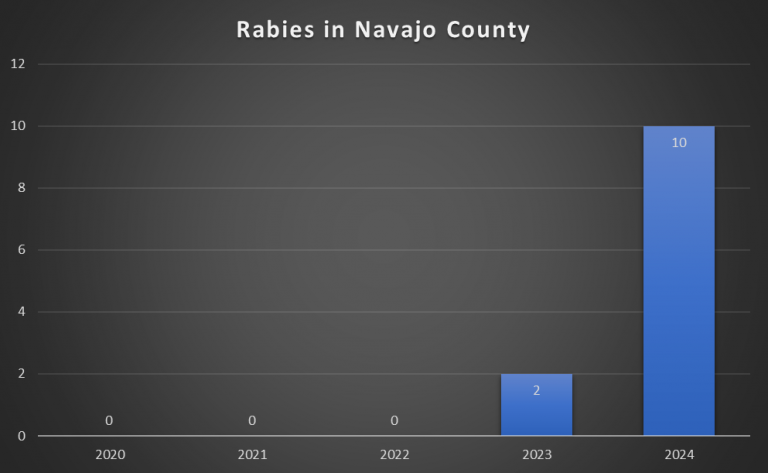
- Details
- By Rhonda Krouse, for the Arizona Dept. of Health
During the summer months, it’s crucial to be aware of the increased risk of rabies. Rabies is an illness you get from an infection with the rabies virus, which can be transmitted to humans primarily through bites or scratches from infected animals. With the recent surge in rabies cases in Navajo County, especially among gray foxes, it’s important for everyone to take precautions and stay informed about the risks associated with this deadly disease.
In 2023, one domestic dog and one fox tested positive for rabies in Navajo County. In 2024, the number of positive rabies cases has increased significantly, with nine foxes testing positive. These statistics highlight the escalating concern surrounding rabies in the area and the need for more education and awareness of this virus. We are currently awaiting test results for several animals to determine if they have been infected with rabies.
There is a higher risk of transmission to domestic animals and humans leading to potential health risks.
Seek immediate medical care if you may have been exposed to rabies. Rabies is preventable if you receive a rabies vaccine quickly after exposure, but is fatal if not treated before symptoms start. Rabies causes symptoms including seizures, hallucinations and paralysis. Report any bite or contact exposures immediately to animal control and health officials.
Don’t feed, touch, nurse to health, or adopt wild animals, stray dogs, or cats.
Be sure your dogs, cats, and ferrets are up to date on their rabies vaccinations. Vaccinated pets serve as a buffer between rabid wildlife and humans. Protect them, and you may reduce your risk of exposure to rabies. If your pet encounters a wild animal with a high risk of rabies infection including foxes, coyotes, skunks, raccoons, or bats, contact a veterinarian immediately. Wear gloves when touching or transporting your pet for care.
Unfortunately, due to an increase in positive rabies cases, the gray fox population on the mountain is facing a serious threat. An increase in rabies can impact the local wildlife population, with potential effects on the ecosystem. Furthermore, an increase in rabies can impact human-animal interactions, leading to changes in behavior and potential conflicts with wildlife. It’s important for public health, wildlife agencies and communities to address the increase in rabies cases to safeguard residents and visitors alike.
Stay safe and keep an eye on your surroundings when spending time outdoors. If you see an animal acting aggressively or erratically, contact animal control and/or the Arizona Game and Fish Department at 623-236-7201.
Rhonda Krouse is currently Code Enforcement Division Manager for Navajo County and oversees animal care and control, the medical examiner and environmental health. She has more than twenty years of experience as a first responder including as a dispatcher, law enforcement officer, emergency manager and currently reserves as a firefighter and emergency medical technician. She has several degrees including one in Fire Science, one in Criminal Justice and a bachelor's degree in Emergency Management.
Help us tell the stories that could save Native languages and food traditions
At a critical moment for Indian Country, Native News Online is embarking on our most ambitious reporting project yet: "Cultivating Culture," a three-year investigation into two forces shaping Native community survival—food sovereignty and language revitalization.
The devastating impact of COVID-19 accelerated the loss of Native elders and with them, irreplaceable cultural knowledge. Yet across tribal communities, innovative leaders are fighting back, reclaiming traditional food systems and breathing new life into Native languages. These aren't just cultural preservation efforts—they're powerful pathways to community health, healing, and resilience.
Our dedicated reporting team will spend three years documenting these stories through on-the-ground reporting in 18 tribal communities, producing over 200 in-depth stories, 18 podcast episodes, and multimedia content that amplifies Indigenous voices. We'll show policymakers, funders, and allies how cultural restoration directly impacts physical and mental wellness while celebrating successful models of sovereignty and self-determination.
This isn't corporate media parachuting into Indian Country for a quick story. This is sustained, relationship-based journalism by Native reporters who understand these communities. It's "Warrior Journalism"—fearless reporting that serves the 5.5 million readers who depend on us for news that mainstream media often ignores.
We need your help right now. While we've secured partial funding, we're still $450,000 short of our three-year budget. Our immediate goal is $25,000 this month to keep this critical work moving forward—funding reporter salaries, travel to remote communities, photography, and the deep reporting these stories deserve.
Every dollar directly supports Indigenous journalists telling Indigenous stories. Whether it's $5 or $50, your contribution ensures these vital narratives of resilience, innovation, and hope don't disappear into silence.
 The stakes couldn't be higher. Native languages are being lost at an alarming rate. Food insecurity plagues many tribal communities. But solutions are emerging, and these stories need to be told.
The stakes couldn't be higher. Native languages are being lost at an alarming rate. Food insecurity plagues many tribal communities. But solutions are emerging, and these stories need to be told.
Support independent Native journalism. Fund the stories that matter.
Levi Rickert (Potawatomi), Editor & Publisher
